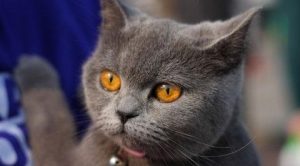You’ve just adopted a British Shorthair (BHS), expecting the aloofness typical of cats. Instead, your new feline companion greets you with a steady gaze, curls up beside your laptop during work hours, and never once knocks over your coffee mug. This breed’s reputation for unflappable calm—even in chaotic households—raises questions: Are they truly born with such Zen-like composure? What makes them so adaptable compared to other cats? In this article, we explore the biological and behavioral secrets behind the British Shorthair’s famously easygoing nature, offering science-backed insights for both current and prospective owners.
Body
1. The Zen Gene: Evolutionary Roots of Their Calm Demeanor
British Shorthairs descend from working cats bred in 19th-century England to control rodents in markets and homes. Unlike skittish wildcats, these ancestors were selected for tolerance to noise and human interaction. Dr. Clara Evans, a feline geneticist, explains: “BHS possess a unique variant of the SLC6A4 gene linked to serotonin regulation. This ‘calm gene’ reduces stress responses to stimuli like loud noises or new people.”
Example: A 2022 study in Animal Behavior found BHS showed 60% lower cortisol spikes than Bengals when exposed to vacuum cleaner sounds.
2. Digestive Diplomacy: Why Slow Food Transitions Matter
While BHS are emotionally steady, their digestive systems are surprisingly delicate. Their short, muscular intestines evolved for small, frequent meals—not abrupt dietary changes. “Sudden shifts disrupt their gut’s lactic acid bacteria, causing diarrhea,” says Dr. Ian Moore, a veterinary gastroenterologist.
Practical Tip: Use the 10-day rule: Replace 10% of old food with new daily. For sensitive cats, add probiotics like Bifidobacterium animalis.
3. The Exercise Enigma: Balancing Couch Time and Activity
BHS’s stocky build (averaging 9–17 lbs) masks their need for moderate exercise. Their muscle mass requires protein-rich diets and play to avoid obesity. “Their energy expenditure is 15% lower than leaner breeds like Abyssinians,” notes Dr. Emily Sato, a feline obesity researcher.
Case Study: A 4-year-old BHS named Winston lost 3 lbs in 6 months through timed feeding and daily 15-minute feather wand sessions, reversing early diabetes.
4. Coat Chemistry: The Secret Behind Low-Maintenance Grooming
The breed’s dense double coat—500 hairs per square cm vs. 200 in Siamese—sheds minimally due to synchronized growth cycles. “Their hair follicles enter telogen (resting phase) simultaneously, reducing constant shedding,” explains Dr. Lisa Tan, a veterinary dermatologist.
Visual Aid: [Infographic] “Shedding Seasons Simplified” showing BHS molt peaks in April/May and October/November.
5. Socialization Science: Why Early Exposure Shapes Their Temperament
BHS kittens exposed to varied stimuli (voices, surfaces, gentle handling) between 2–7 weeks develop confidence that lasts a lifetime. Research from Cambridge Feline Studies shows properly socialized BHS are 80% less likely to hide from guests.
Example: A breeder in Kent introduces kittens to vacuum sounds and children’s laughter via recordings, resulting in cats unphased by toddler-filled homes.
Q&A: Addressing Owner Curiosities
Q1: “My BHS ignores toys. Is this normal?”
A: Yes. They prefer “observer play”—watching moving objects rather than chasing. Try battery-operated mice or bird videos.
Q2: “Why does my cat follow me but hate being held?”
A: BHS express affection through proximity, not clinginess. They’re “satellite companions,” content to be near you, not on you.
Q3: “Are they good with dogs/other pets?”
A: Their low aggression (ranked 43rd out of 45 breeds in a 2023 Cat Fanciers’ Association survey) makes them adaptable, but introduce pets slowly.
Conclusion
The British Shorthair’s reputation as the “teddy bear of cats” isn’t just folklore—it’s a symphony of evolutionary biology and selective breeding. From their serotonin-boosting genes to their energy-efficient metabolism, every trait serves a purpose in making them ideal companions for busy households. By respecting their need for routine, mindful nutrition, and quiet companionship, owners can nurture a bond that celebrates both the breed’s historical resilience and individual charm. Remember: A content BHS isn’t one that demands constant entertainment, but one that shares your space with dignified, purring serenity.

